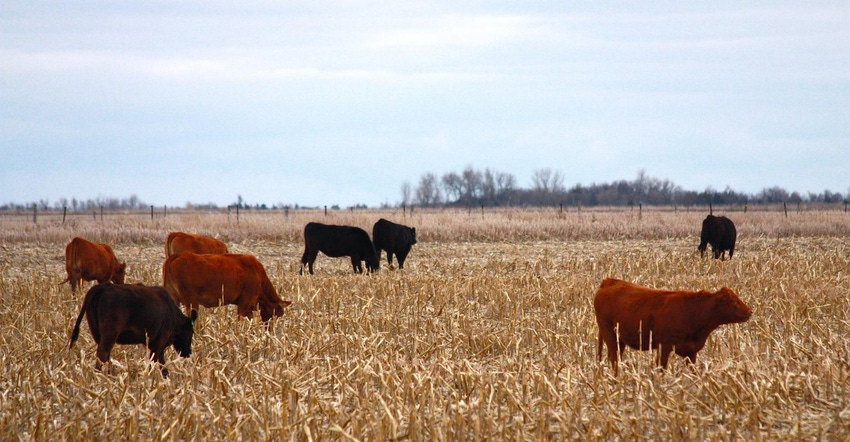As cattle graze corn stalks and other crop residues, there are some considerations to keep in mind.
October 7, 2020

It’s been a beautiful October in our neck of the woods. Harvest is going well and is ahead of schedule. The weather has cooperated, and hopefully that trend continues as we wean and work calves this weekend. The cow herd is grazing corn stalks, and aside from some manure still left to haul, things are humming along around here.
Heck, if we didn’t turn on the news or go on social media, we wouldn’t even be aware of the turmoil going on in our country today. It’s quiet and peaceful out here — that’s exactly how we like it! Of course, we know that out of sight and out of mind is no way to prepare for and handle the challenges that may be coming our way this year, but that’s a topic for another day.
Today, I want to relish in seeing our cattle grazing corn stalk residues, effectively up cycling a by-product of crop production and converting it into nutritious beef and life-enriching by-products while they fertilize and aerate the soil. It really is a win-win.
But is corn stalk grazing as simple as putting up a hot wire and turning them loose?
Maybe a little refresher course is in order. I’ve rounded up a few resources for your reference as you prepare to graze corn stalks and other crop residues this fall.
1. “Grain overloads: A possible consequence of cornstalk grazing” by Russ Daly, South Dakota State University Extension veterinarian
Daly writes, “When the possibility of overloads is present, prevention is much better than having to deal with affected animals. Using electric fencing to allow gradual access to a cornfield may be a good idea if a large amount of grain is present in the field. In some cases, it may be possible to adapt animals to a high-grain diet over a period of time. Corn residues are a great source of winter feed, but in certain situations, cattle producers should be aware of this potential hazard when utilizing cornstalks.”
2. “Grazing corn stalks a thrifty feed option” by Krissa Welshans for Feedstuffs
Welshans writes, “While lower feed costs have provided relief to producers' bottom line, cattle producers have an additional option every fall to cut costs even further by grazing corn stalks. However, producers planning to utilize corn stalks this year should be aware that a wet fall will negatively affect grain and corn stalk quality for cattle, so management adjustments will need to be made.
“Julie Walker, South Dakota State University Extension beef specialist and associate professor, recently explained that feed is the largest expense for a cow/calf operation, comprising more than 50% of a livestock producer's annual production costs.”
3. “Keys for corn stalk grazing” by Aaron Berger, University of Nebraska-Lincoln Extension educator
Berger writes, “Stocking rate should be determined based on corn bushel yield per acre and the average weight of cattle that will be grazing. A quick way to estimate grazing days per acre available for a 1200-pound non-lactating cow is to take corn bushel yield and divide by 3.5. For example, 180-bushel yield / 3.5 = 51 grazing days per acre.”
4. “Grazing corn stalks with beef cattle” featured on PennState Extension
According to the article, “While managed grazing of corn residue can help optimize the number of grazing days possible, it is always important to keep in mind how probable it may be. Weather can often be the major factor determining the actual number of grazing days in an operation. Corn crop residue grazing works great after corn harvest until winter weather conditions start kicking in. In fact, most beef cows can successfully graze corn residue fields that have up to 4 to 6 inches of snow cover. However, cattle will not be able to graze fields that are covered with ice.”
Do you have any additional tips for grazing corn stalks that you would add to this list? Drop your suggestions in the comments section below.
The opinions of Amanda Radke are not necessarily those of beefmagazine.com or Farm Progress.
About the Author(s)
You May Also Like





